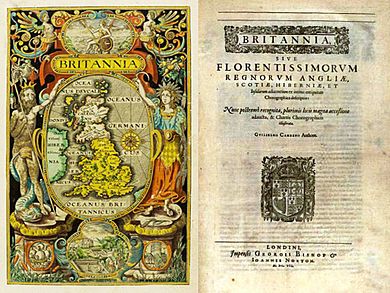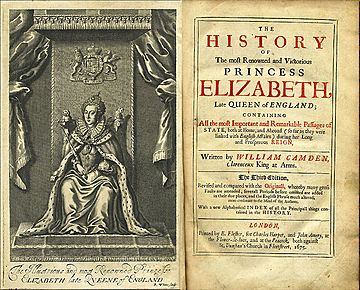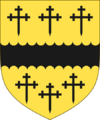William Camden facts for kids
Quick facts for kids
William Camden
|
|
|---|---|
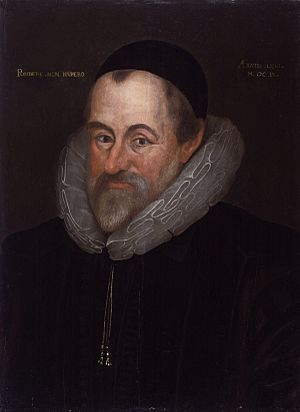
William Camden
|
|
| Born | 2 May 1551 London, England |
| Died | 9 November 1623 (aged 72) Chislehurst, England |
| Occupation | Antiquarian, historian, topographer |
William Camden (born May 2, 1551 – died November 9, 1623) was an English expert on old things (an antiquarian). He was also a historian, a writer about places (a topographer), and an official who dealt with coats of arms (a herald). He is most famous for his book Britannia. This book was the first detailed survey of the geography and history of Great Britain and Ireland. He also wrote Annales, which was the first detailed history of Queen Elizabeth I of England's time as queen.
Contents
Early Life and Studies
William Camden was born in London. His father, Sampson Camden, was a painter. William went to Christ's Hospital and St Paul's School. In 1566, he started studying at Oxford.
At Oxford, he met Philip Sidney. Sidney encouraged Camden's interest in old things and history. Camden returned to London in 1571 without finishing his degree. In 1575, he became a teacher at Westminster School. This job allowed him to travel and do his research during school holidays.
Britannia: Exploring Britain's Past
In 1577, William Camden started his most important book, Britannia. He was encouraged by a mapmaker named Abraham Ortelius. Britannia was a detailed look at the geography and history of all of Great Britain and Ireland.
Camden wanted to "restore antiquity to Britaine, and Britain to his antiquity." This means he wanted to bring back the old history of Britain. He also wanted to show how Britain's past was still visible in the land today.
The first version of Britannia was written in Latin and came out in 1586. It was very popular! More Latin versions were published, each with more information and pictures. The 1607 edition was the first to include maps of English counties. These maps were based on surveys by Christopher Saxton and John Norden.
The first English version of Britannia was translated by Philemon Holland in 1610. Camden added even more content to this edition.
Britannia describes Great Britain and Ireland county by county. It connects the landscape, geography, old things, and history. Instead of just writing a history book, Camden wanted to describe Britain as it was then. He showed how old traces of the past could be seen in the land. This way, he created the first clear picture of Roman Britain.
Camden kept collecting information and updating Britannia his whole life. He used the work of other experts like John Leland and William Lambarde. He also had many friends who helped him with their own research.
He traveled all over Great Britain to see old documents, places, and objects himself. He visited many areas, including East Anglia, Yorkshire, Wales, and even Hadrian's Wall. His way of doing research by visiting places set new high standards for his time. He even learned Welsh and Old English to help with his work!
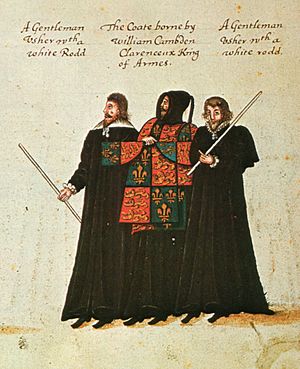
In 1593, Camden became the headmaster of Westminster School. He held this job for four years. Then, he was given a new important role as Clarenceux King of Arms. By this time, Camden was very famous because of Britannia. This new job meant he didn't have to teach anymore, which gave him more time for his research.
The College of Arms was a place for studying family histories and coats of arms. It was also a center for studying old things. However, this new job made another official, Ralph Brooke, jealous. Brooke attacked Britannia, saying Camden was wrong and copied others. But Camden successfully defended his work in later editions of the book.
Britannia was seen as a very important book across Europe. Parts of it were even published in other countries like Germany and the Netherlands.
Annales: A Look at Queen Elizabeth's Reign
In 1597, William Cecil, 1st Baron Burghley, suggested that Camden write a history of Queen Elizabeth's time as queen. Camden started this work, called Annales, in 1607.
The first part of Annales came out in 1615. It covered Elizabeth's reign up to 1588. The second part was finished in 1617 but was published after Camden's death.
The Annales were not written like a continuous story. Instead, they listed events year by year, like a diary. Some people said the book was too kind to Queen Elizabeth and King James I. However, the Annales are still one of the most important history books from that time. They greatly shaped how people later viewed the Elizabethan age.
Recently, in 2023, hidden parts of the Annales became readable using new technology. Camden had changed or covered up some passages. These hidden parts showed that the book was rewritten to make Elizabeth's reign look better for her successor, King James. For example, the book originally said Elizabeth named James VI of Scotland as her successor on her deathbed. The new findings show this scene was added later to support James's claim to the throne. Also, a part about Pope Pius V excommunicating Elizabeth was changed to sound less harsh. These new discoveries might change how we understand Queen Elizabeth and her time.
Remaines Concerning Britain
Camden's Remaines of a Greater Worke, Concerning Britaine was a collection of essays about history. It was meant to be a more popular book than Britannia. This was the only book Camden wrote in English.
Even though Camden called it "rude rubble" from his bigger work, he actually planned Remaines as a separate project from the start. Remaines was published many times. It is often the first or only book cited for certain words in the Oxford English Dictionary. It also has the first alphabetical list of English proverbs.
Reges, reginae: Westminster Abbey Guide
In 1600, Camden secretly published Reges, reginae, nobiles et alii in ecclesia collegiata B. Petri Westmonasterii sepulti. This was a guidebook to the many tombs and epitaphs in Westminster Abbey. It was a new kind of book for its time and became very popular. Two more updated versions came out in 1603 and 1606.
Other Writings
Camden also wrote other books. These included a Greek grammar textbook that was used in schools for over 100 years. He also translated the trial of the Gunpowder Plotters into Latin for people in other countries to read. He wrote an essay about printing and some Latin poems.
Later Years and Legacy

In 1609, Camden moved to Chislehurst in Kent. Even though he was often sick, he kept working hard. In 1622, he started a special teaching position (a lectureship) for history at Oxford University. This was the first of its kind in the world! It still exists today as the Camden Professor of Ancient History.
That same year, he became paralyzed. He died in Chislehurst on November 9, 1623. He was buried at Westminster Abbey. You can still see his monument there, which shows him holding a copy of Britannia.
Camden left his books to his former student and friend, Sir Robert Cotton. Cotton created the famous Cotton library. Camden had many famous friends, including writers like Edmund Spenser and Ben Jonson. Jonson was even Camden's student at Westminster School.
Camden's Lasting Impact
Camden's Britannia remained an important and respected book for many years after he died. New and updated versions were published throughout the 17th and 18th centuries. Experts still say that his work helps us understand how we look at our country's history today.
The newly readable hidden parts of the Annales from 2023 might change how people understand Queen Elizabeth's time as queen.
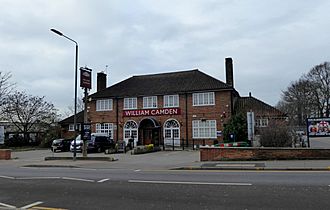
The history teaching position at Oxford that Camden started is still active today. It is now focused on Roman history.
The Camden Society was named after William Camden. It was started in 1838 to publish old historical and literary writings. Today, it is part of the Royal Historical Society.
Another group, the Cambridge Camden Society, was also named after him. It was started in 1839 by students at Cambridge University to study Gothic architecture. This group was very important in bringing back the Gothic style in the 1800s.
After Camden died, his old home in Chislehurst became known as Camden Place. Later, a judge named Charles Pratt bought it. He was given the title Baron Camden. His family owned land north of London and developed it. This is how places like Camden Town and the London Borough of Camden got their names from William Camden!
Images for kids
See Also
 In Spanish: William Camden para niños
In Spanish: William Camden para niños


